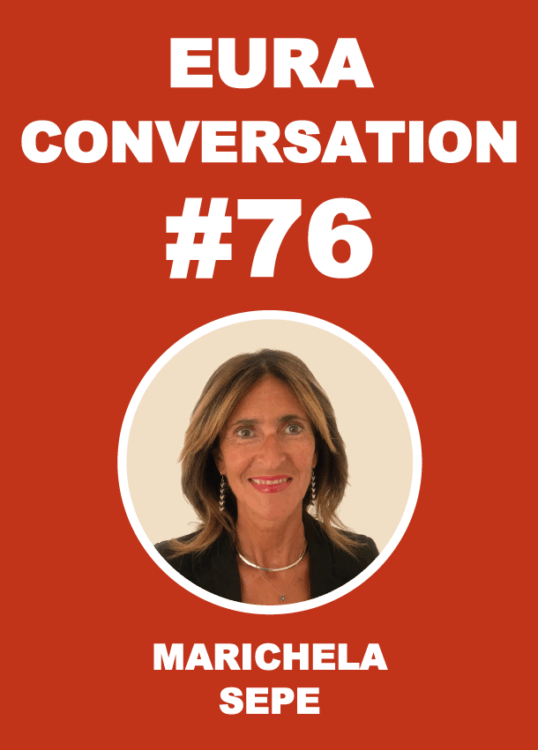
EURA 2025 – Acknowledgment
24/06/2025
EURA Updates – July 2025
14/07/2025
Conversation #74
Cityscapes of Creativity.Exploring Urban Life with Creative Methods
by Juliet Carpenter
Kellogg College, University of Oxford, UK
 In spring 2024, in a New York conference room at the International Conference on Urban Affairs, academics put heads together and cogitated on the evolution of the EURA Conversation blog series. One result of that meet-up? A twin series of blogs, written by myself and my colleague from the University of Palermo, Dr Stefania Crobe, focusing on our shared passion: arts-based methods in urban research.
In spring 2024, in a New York conference room at the International Conference on Urban Affairs, academics put heads together and cogitated on the evolution of the EURA Conversation blog series. One result of that meet-up? A twin series of blogs, written by myself and my colleague from the University of Palermo, Dr Stefania Crobe, focusing on our shared passion: arts-based methods in urban research.
Stefania’s initial engaging piece, published as EURA Conversation #68, makes a strong case for the importance of arts-based and creative methods to capture the nuances of urban experiences. She argues that urban research can benefit from creative methods, through uncovering hidden stories, engaging different communities and contributing to reimagining alternative urban futures. This current corollary piece builds on those arguments, and the conversation they prompted, to demonstrate the power of arts-based approaches in urban research.
One of the most compelling components of arts-based approaches, is the act of giving voice to those who are traditionally unheard in the urban arena. Let me illustrate this with two recent examples. One involved the method of photovoice, a participatory research approach that allows participants to capture their lived experience through photography. The project focused on Vancouver’s Downtown Eastside, a neighbourhood with a series of complex social issues, including homelessness, drug use, poverty and mental illness.
Research participants were each given a single-use camera to document the places in the neighbourhood that were meaningful to them. During a series of ‘show and tell’ workshops held locally, the participants elaborated on the meaning of their photos, exchanged stories of their lived experiences, and developed deeper understandings of the importance of different local places for the participants, prompted by the photos. As the term suggests, ‘photovoice’ is as much about the photograph, as it is about the voice. The resulting images, as well as the accompanying texts derived from the workshops, were compiled together into an exhibition co-curated with the participants, that was displayed in the ‘Learning Exchange’ venue in the Downtown Eastside neighbourhood, and open to the general public. The photos and accompanying texts had a powerful impact, as they gave voice to the community’s everyday experiences, including emotions, memories and aspirations, offering the researcher more inclusive ways of understanding the city than through traditional research methods (Carpenter, 2022; Asakura et al, 2024).
The second example comes from the Global South, more specifically, the favela of Santa Marta in Rio de Janeiro, Brazil. Here, participatory co-creation workshops, including photovoice and participatory mapping, gave favela residents the opportunity to creatively explore the different meanings of spaces in the favela and beyond, questioning dominant narratives about the area and providing alternative views and imaginaries. For researchers, these arts-based methods offered the opportunity to open up avenues for new thinking, providing counter-narratives embedded in the lived experiences and daily lives of favela residents (Carpenter et al, 2021).
And while EURA is a European-focused research association, we are fully mindful of wider approaches, different types of knowledge, including from communities carrying knowledges that have previously been ignored outside the Global North – what de Sousa Santos (2018) calls ‘epistemologies of the South’ – that can often be expressed through non-traditional or arts-based methods. Similarly, indigenous communities are often neglected as knowledge holders in research. But often, indigenous groups embrace and nurture creative and arts-based ways of knowing within their own cultural traditions. As the urban planning scholar Leonie Sandercock (2023) argues, drawing on her work with indigenous communities in Canada, creative approaches such as storytelling are critical for understanding the emotional and experiential knowledges held by First Nations communities. This includes indigenous worldviews that emphasise learning from nature, environmental stewardship and community engagement. Culturally grounded research methods that draw on arts-based approaches, particularly oral traditions, are critical to understanding the worldviews of different communities globally.
Which brings us into some of the integral components of arts-based methods, particularly in relation to ethical aspects. As with all research methods, deep-rooted power asymmetries embedded within society need to be acknowledged and mitigated when using creative methods. Similarly, acknowledging power imbalances between researchers and research participants is also crucial, particularly in research exploring lived experiences that can involve exposing participants to vulnerability.
Positionality and reflexivity are also a critical part of the research process using creative methods. Our positionality reflects a self-awareness that we exercise around our identity: who we are, and what we bring to the research. Reflexivity on the other hand, involves our on-going reflections on how our identity/ies impact the research process, acknowledging our subjectivity in the face of research questions, methods and interpretations. Both aspects are crucial for creative research practices, in the dialogical relationship between researcher and research participants.
So here, we are not arguing to replace traditional research methods with arts-based approaches, but rather, that the two are used in parallel to complement each other, integrating insights from creative methods with other traditional approaches. For urban research is a complex field, with multiple perspectives and voices. Arts-based approaches are vital to capture the emotion and everyday lived experiences of the city, to enhance our understanding, build up new understandings, that can contribute to creating more just, inclusive and vibrant cities of the future.
References:
Asakura, J., Hobson, B., Joshi, S., & Phillips-Houle, J. (2024, April 30). Picture this : Exploring photovoice as a method to understand lived experiences in marginal neighbourhoods .
Carpenter, J. (2022). Picture this: Exploring photovoice as a method to understand lived experiences in marginal neighbourhoods. Urban Planning, 7(3), 351-362.
Carpenter, J., Horvath, C., and Spencer, B. (2021). Co-Creation as an agonistic practice in the favela of Santa Marta, Rio de Janeiro. Urban Studies, 58(9), 1906-1923.
de Sousa Santos, B. (2018). The End of the Cognitive Empire: The Coming of Age of Epistemologies of the South. Durham NC: Duke University Press.
Sandercock, L. (2023). Mapping Possibility: Finding Purpose and Hope in Community Planning. London: Routledge.
Sultana, F. (2007). Reflexivity, positionality and participatory ethics: Negotiating fieldwork dilemmas in international research. ACME: An international journal for critical geographies, 6(3), 374-385.





